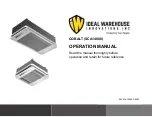
20
9.1. Before test run
After completing installation and the wiring and piping of the indoor and
outdoor units, check for refrigerant leakage, looseness in the power supply or
control wiring, wrong polarity, and no disconnection of one phase in the supply.
Use a 500-volt megohmmeter to check that the resistance between the
power supply terminals and ground is at least 1.0 M
Ω
.
Do not carry out this test on the control wiring (low voltage circuit)
terminals.
Warning:
Do not use the air conditioner if the insulation resistance is less than 1.0 M
Ω
.
Insulation resistance
After installation or after the power source to the unit has been cut for an
extended period, the insulation resistance will drop below 1 M
Ω
due to refrigerant
accumulating in the compressor. This is not a malfunction. Perform the following
procedures.
1. Remove the wires from the compressor and measure the insulation resistance
of the compressor.
2. If the insulation resistance is below 1 M
Ω
, the compressor is faulty or the
resistance dropped due the accumulation of refrigerant in the compressor.
3. After connecting the wires to the compressor, the compressor will start to warm
up after power is supplied. After supplying power for the times indicated below,
measure the insulation resistance again.
• The insulation resistance drops due to accumulation of refrigerant in the
compressor. The resistance will rise above 1 M
Ω
after the compressor is
warmed up for two to three hours.
(The time necessary to warm up the compressor varies according to
atmospheric conditions and refrigerant accumulation.)
• To operate the compressor with refrigerant accumulated in the compressor,
the compressor must be warmed up at least 12 hours to prevent breakdown.
4. If the insulation resistance rises above 1 M
Ω
, the compressor is not faulty.
Caution:
• The compressor will not operate unless the power supply phase connection
is correct.
• Turn on the power at least 12 hours before starting operation.
- Starting operation immediately after turning on the main power switch can result
in severe damage to internal parts. Keep the power switch turned on during the
operational season.
9. Test run
9.2. Test run
9.2.1. Using wired remote controller (option)
①
Turn on the power at least 12 hours before the test run.
②
Press the [TEST] button twice.
➡
“TEST RUN” liquid crystal display
③
Press the [Mode selection] button.
➡
Make sure that wind is blown out.
④
Press the [Mode selection] button and switch to the cooling (or heating) mode.
➡
Make sure that cold (or warm) wind is blown out.
⑤
Press the [Fan speed] button.
➡
Make sure that the wind speed is switched.
⑥
Check operation of the outdoor unit fan.
⑦
Release test run by pressing the [ON/OFF] button.
➡
Stop
⑧
Register a telephone number.
The telephone number of the repair shop, sales office, etc., to contact if an
error occurs can be registered in the remote controller. The telephone number
will be displayed when an error occurs. For registration procedures, refer to the
operation manual for the indoor unit.
[Fig. 9-2-1] (P.11)
Ⓐ
ON/OFF button
Ⓑ
Test run display
Ⓒ
Indoor temperature liquid line temperature display
Ⓓ
ON/OFF lamp
Ⓔ
Power display
Ⓕ
Error code display
Test run remaining time display
Ⓖ
Set temperature button
Ⓗ
Mode selection button
Ⓘ
Fan speed button
Ⓜ
TEST button
9.2.2. Wired remote controller
①
Turn on the power.
②
Press the [CHECK] button twice.
③
Set refrigerant address with [TEMP] button if system control is used.
④
Press the [ON/OFF] button to stop the self-check.
[Fig. 9-2-2] (P.11)
Ⓐ
CHECK button
Ⓑ
Refrigerant address
Ⓒ
TEMP. button
Ⓓ
IC: Indoor unit
OC: Outdoor unit
Ⓔ
Check code
• For description of each check code, refer to the following table.
①
Check code
Symptom
Remark
P1
Intake sensor error
Each unit has two each of the
following: intake sensors, liquid
pipe sensors, 2-phase pipe
sensors, and fan motors. When
a problem occurs with one of
any of the items above, an error
code (P1, P2, P8, P9, or PB)
will appear. When an error code
appears, check both of the items.
P2, P9
Pipe (Liquid or 2-phase pipe) sensor error
E6, E7
Indoor/outdoor unit communication error
P4
Drain sensor error
P5
Drain pump error
PA
Forced compressor error
PB
Fan motor error
P6
Freezing/Overheating safeguard operation
EE
Communication error between indoor and outdoor units
P8
Pipe temperature error
E4
Remote controller signal receiving error
Fb
Indoor unit control system error (memory error, etc.)
E0, E3
Remote controller transmission error
E1, E2
Remote controller control board error
E9
Indoor/outdoor unit communication error (Transmitting error) (Outdoor unit)
For details, check the LED display
of the outdoor controller board.
UP
Compressor overcurrent interruption
U3, U4
Open/short of outdoor unit thermistors
UF
Compressor overcurrent interruption (When compressor locked)
U2
Abnormal high discharging temperature/49C worked/insufficient refrigerant
U1, Ud
Abnormal high pressure (63H worked)/Overheating safeguard operation
U5
Abnormal temperature of heat sink
U8
Outdoor unit fan safeguard stop
U6
Compressor overcurrent interruption/Abnormal of power module
U7
Abnormality of super heat due to low discharge temperature
U9, UH
Abnormality such as overvoltage or voltage shortage and abnormal synchronous signal to main circuit/
Current sensor error
Others
Other errors (Refer to the technical manual for the outdoor unit.)
• On wired remote controller
①
Check code displayed in the LCD.
Summary of Contents for Mr.Slim PEA-RP100
Page 23: ......





































